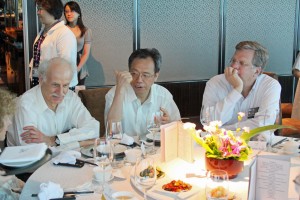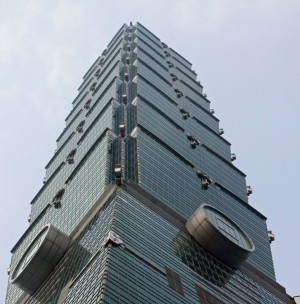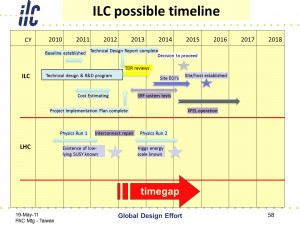
Our host Shih Chang (S.C.) Lee hosted a banquet at '101,' until recently the world’s tallest building. He is sitting between Roy Rubinstein, PAC secretary, and Jon Bagger, ILCSC chair.
The ILC Program Advisory Committee (PAC) held their semi-annual review of the ILC detector and accelerator programmes at Academia Sinica in Taipei, Taiwan from 19-20 May. In addition to their specific recommendations on the detector and accelerator programmes, they repeated their general recommendation: “As at the previous PAC meeting, the PAC again recommends the need for ILCSC [ILC Steering Committee] and ICFA [International Committee for Future Accelerators] to work towards a post-2012 strategy for ILC activities, so that the accelerator and detector teams can efficiently continue their work after completion of the TDR [Technical Design Report] and DBD [Detailed Baseline Design] documents.” I comment on this crucial issue from the standpoint of the Global Design Effort today and will address the committee’s specific recommendations next week.
The Program Advisory Committee is the technical subcommittee of the International Linear Collider Steering Committee that provides oversight for the GDE effort for the scientific community. The PAC conducts semi-annual reviews jointly of the progress of both the detector and accelerator programmes. Although the main part of the meeting was focused on detailed technical reviews, the committee discussed longer-term strategic issues, They discussed with us both the scope and content of the final deliverable from our programme, the TDR, and strategic issues regarding the next steps beyond the TDR.
Below, I share some of the key points we made regarding the post-2012 programme during the review. I emphasise that this is an ongoing dialogue and we expect the plans will both evolve and become more definite over the coming year. However, the next meeting of the International Linear Collider Steering Committee will be especially important as they plan to place special emphasis on this issue.
The crux of the issue is illustrated in the timeline. At the end of 2012, we are planning to complete the mandate for the Global Design Effort to produce a complete the Technical Design Report. As of today, we are on schedule to complete that task, including the critical R&D demonstrations needed to make a solid construction proposal to the world’s funding agencies. However, in order to make such a proposal, the physics case needs to be established from CERN’s Large Hadron Collider (LHC) results, including determining the energy and other parameters required for a new machine to complement the LHC in exploiting terascale physics.

Reaching for the sky! The '101' building, which served as a very appropriate banquet venue for the PAC review.
The LHC is now running very well and the amount of data that we project will be collected and analysed by the end of 2012 could go a long way towards establishing the physics case, or it may require the long shutdown and the following run at higher energy before we are ready to propose a linear collider. Also, depending on these results, we hope to determine the maximum energy needed for the companion lepton collider in order to most effectively exploit LHC physics. The LHC results will more generally help guide ILC parameters, and give us some idea whether other technical approaches like the Compact Linear Collider (CLIC) Study technology or a muon collider need to be pursued to reach high enough energy.
With all of this in mind, we have been considering what type of ILC programme makes sense after completion of the TDR, assuming there will be a significant time gap before a decision can be made to proceed with a new project. The general theme we have been considering for a post-2012 programme is one focused on R&D towards a higher energy machine of about one teraelectronvolt (TeV) (the primary design for the TDR is for 0.5 TeV). This would provide us with a flexible way to optimise the design up to about 1 TeV, again depending on LHC results. The challenge will be to achieve higher energy without significantly increasing the cost and power consumption. A combination of achieving higher operating gradients through continuing superconducting radiofrequency research and through value engineering optimisation of the TDR design will be central to this programme. The higher gradients may be possible through work on materials, cavity shapes, etc., and cost containment through improved cryomodules design and other design simplifications.
One consideration that we consider central to all detailed plans for a programme beyond 2012 is the need to preserve certain features that have been so successful in the GDE organisation. Perhaps the most important of those attributes have been the ability of the GDE to set priorities and make decisions globally and our ability to centrally coordinate the actual R&D programme. As mentioned above, the next serious step in considering the post-2012 period will be at the ILCSC meeting during the Lepton-Photon Conference in Mumbai in August.



Recent Comments